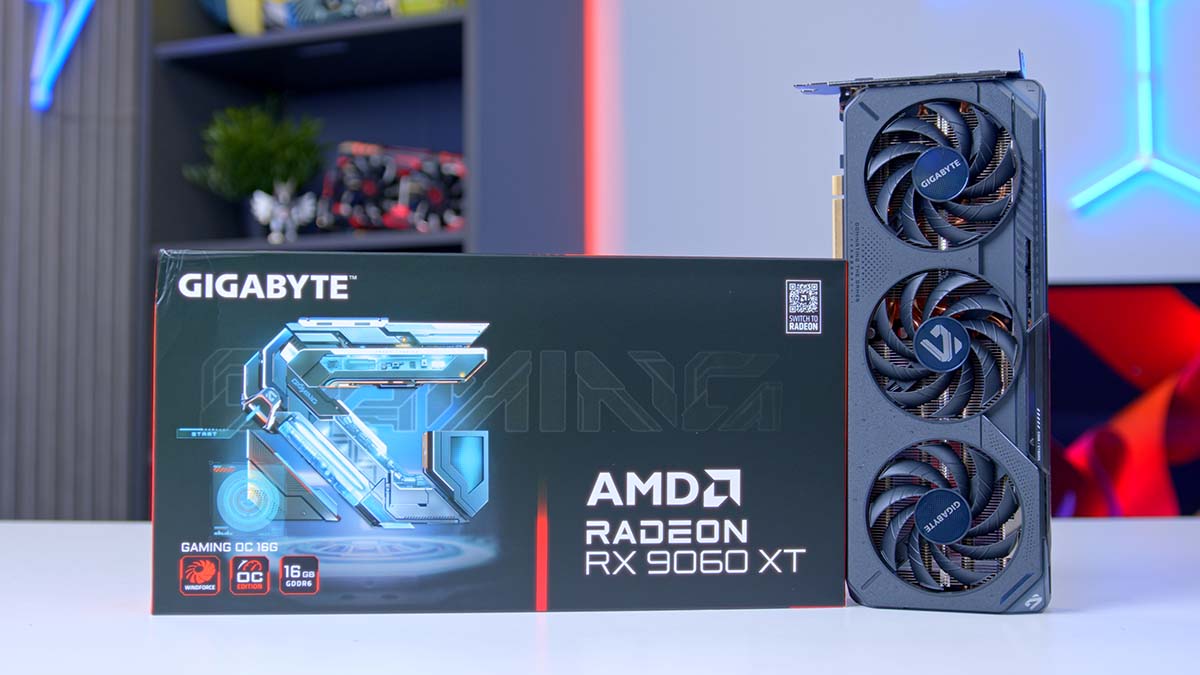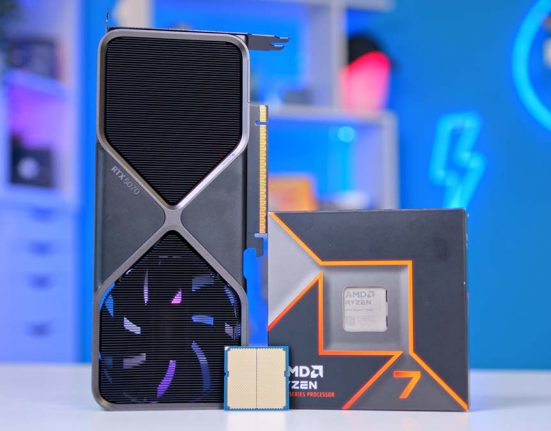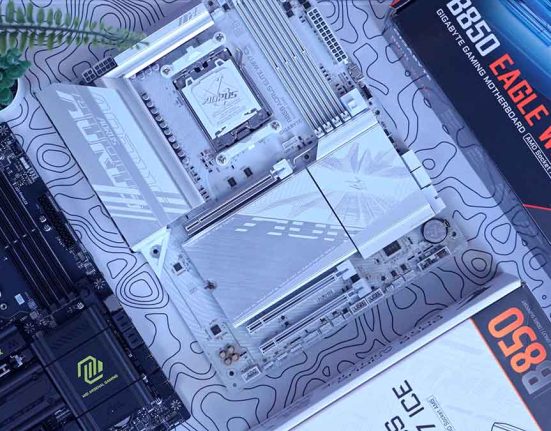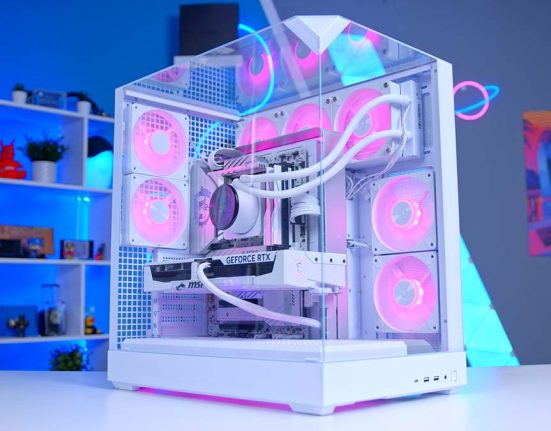The AMD Radeon RX 9060 XT has finally arrived. After what can be described as a turbulent year for graphics cards, AMD seem to be one of the few manufacturers succeeding in the graphics card space. With the RX 9070 and RX 9070 XT being received with overwhelming positivity despite their lack of MSRP stock, all signs point towards the RX 9060 XT hitting the ground running.
Announced at Computex 2025, just a couple of weeks before its official release, the RX 9060 XT comes in two variants, with 16GB and 8GB VRAM capacities. AMD sets the MSRP at $349 for the 16GB card and $299 for the 8GB version, positioning it fairly competitively compared to the $299 RTX 5060 from NVIDIA. Ultimately, we’d love to see a return to form with a sub-$300 card, similar to what we saw with the Radeon RX 7600. However, with inflation, increased material costs, and certain political factors that we won’t delve into here, it’s no surprise that the 9060 XT is sitting at this price point.
The big question for us, other than where performance lies, is why AMD is persistent in offering 8GB cards. While we don’t want to keep repeating ourselves, 8GB of VRAM is no longer viable. Games have become increasingly more resource-hungry, with new AAA titles swallowing 10-12GB on average at high and even medium settings. This puts the 8GB version of the RX 9060 XT in an awkward position, as for $50 more, you can receive an upgrade to a 16GB card, which offers a much better value proposition.
However, all of this is speculation until we see some real performance numbers, which is precisely what we’re taking a look at in this review. We’ll be doing a deep dive on the Gigabyte RX 9060 XT Gaming OC 16GB, where we’ve analysed the specs, design, architecture, and performance.
Specification
Switching onto the specs, the RX 9060 XT, as we mentioned earlier, has two VRAM capacities, 16GB and 8GB. Both sit on a 128-bit memory bus and share the same specs, so we’ll primarily be sticking to the 16GB version. In terms of clock speeds, the RX 9060 XT has a healthy boost speed of 3.13GHz, which is approximately 0.6GHz higher than the RX 9070.
Regarding core counts, the RX 9060 XT has 32 compute units and ray tracing units, alongside 2048 stream processors. Based on the core hardware of this card, I don’t think we’ll be seeing strong ray tracing metrics from the RX 9060 XT, but with the assistance of FSR4, performance might be a bit more palatable this time around, compared to the Radeon 7000 series.

Power consumption is relatively low, with the 16GB variant sitting at 160W TGP and the 8GB card drawing 150W. It’s no surprise to see the power draw this low, especially as this is more of a budget graphics card. AMD recommends a 450W power supply as a minimum, so I can foresee plenty of builders looking to kit out a super low-power system with the RX 9060 XT.
Fortunately, AMD didn’t fill their Computex presentation with plenty of AI jargon and gimmicky features. Still, they confirmed that the AI accelerators in the RX 9060 XT are what power FSR4, which is designed to deliver better performance by reducing overhead. Since the introduction of FSR 4 with the RX 9070 XT, this performance-enhancing tech has continued to improve, so much so that the RX 9070 XT was able to beat out the RTX 5070 Ti in certain benchmarks.
| Key Specs | RX 9060 XT 16GB | RX 9060 XT 8GB | RX 9070 |
|---|---|---|---|
| Video Memory | 16GB GDDR6 | 8GB GDDR6 | 16GB GDDR6 |
| Memory Bus | 128-bit | 128-bit | 256-bit |
| Base Clock Speed | 2.22GHz | 2.22GHz | 1.33GHz |
| Boost Clock Speed | 3.13GHz | 3.13GHz | 2.52GHz |
| Stream Processors | 2048 | 2048 | 3584 |
| Compute Units | 32 | 32 | 56 |
| Ray Tracing Units | 32 | 32 | 56 |
| Power Consumption | 160W | 150W | 220W |
| MSRP | $349.99 | $299.99 | $549.99 |
That last central element to cover in the specs is the price. The RX 9060 XT 8GB is priced at $299.99, which is $50 cheaper than the 16GB iteration. This is somewhat similar to the RX 7700 XT and RX 7800 XT, where the slightly more expensive card was the better of the two. While I don’t think the RX 9060 XT 8GB is entirely redundant, it’s not the card we’d recommend out of the two, especially if you’re looking to play a plethora of modern games at decent settings. Additionally, AMD refused to send us an 8GB version of the 9060 XT, making it difficult to comment on the performance without actual data.
Regarding the competition, the primary GPU that the RX 9060 XT faces as a rival is the RTX 5060. We managed to get a hold of an RTX 5060 and gather some performance numbers in time for its launch on May 19th. Performance-wise, it’s a solid card. However, it suffers from the same fate as the RX 9060 XT 8GB, namely, its limited VRAM capacity. It simply just isn’t enough in 2025 for modern games, which is why the RX 9060 XT 16GB version stands out amongst these options.
Design
The Gigabyte Gaming OC variant of the RX 9060 XT is a fairly simple-looking graphics card. It features a black shroud and is equipped with three fans, providing ample airflow to keep it cool. Aesthetically, the Gaming OC version won’t blow you away. The fact that the entire card is black allows it to blend in well with other dark components, but it’s not the most exciting GPU we’ve seen.

On the front of the card, Gigabyte has used a paint splatter effect, which adds a unique texture to the card. It’s nice to see Gigabyte trying something different with its design, but I would have preferred a slightly lighter effect to provide some contrast to the overall look.

Around the back, you’ll spot a backplate that reinforces the card’s structure, providing rigidity and robustness. There’s also a small cutout towards the right side of the card, which allows air to pass through the back.

The top of the Gaming OC RX 9060 XT features a sliding plate design with RGB LEDs underneath. This is, unfortunately, the only area of RGB on the card, but if you’ve installed it normally, the lighting is easily visible and offers builders some extra flair for their system. The lighting can easily be configured within Gigabyte’s Control Center software, allowing you to match the colours or patterns to other components in the build.
Overall, I think the design is fine. The Gaming OC version of the RX 9060 XT isn’t the most visually appealing GPU on the market, but it has a couple of notable qualities that make it more interesting than other GPUs. If you’re looking for a more unique graphics card, it may be worth considering some of the pricier AIBs.
Architecture
Radeon 9000 graphics cards utilise AMD’s RDNA4 architecture. AMD boasts that RDNA4 represents a breakthrough in graphical architecture, with compute units, ray tracing, and AI acceleration all receiving upgrades that provide a better gaming experience across the board. AMD have often thrived in the budget markets, and with enhancements to technologies like FSR (FidelityFX Super Resolution), performance will only improve.
Speaking of FSR, this tech is in its fourth iteration, competing directly with NVIDIA’s DLSS 4. With the updates to FSR in its fourth iteration, AMD has introduced an AI machine learning algorithm to reduce overheads further and redraw on-screen images. Additionally, FSR is a GPU-agnostic technology, meaning it is programmed directly into the game, rather than relying on specific hardware or drivers to function. This allows old-gen cards and competitor GPUs to leverage more frames and crisper gameplay.

One of the key features being introduced as part of this AI algorithm is a reduction in performance cost when ray tracing is enabled. Neural Radiance Caching, one of the three features being added in the second half of 2025, enables an AI model to learn how light bounces, allowing for its prediction and storage, similar to how NVIDIA’s Ray Reconstruction works. The hope is that these features will put FSR4 on par with DLSS 3.5 and 4, significantly increasing the value proposition of Radeon 9000 GPUs.
While we can’t review these features now, it’ll be interesting to see how they hold up against NVIDIA’s DLSS, as it has been argued for quite some time that FSR isn’t as good by comparison, especially when Ray Tracing is thrown into the mix. Hopefully, we’ll see FSR come into its own during the latter half of 2025.
Performance
As always, all of our benchmarking and testing is done by our in-house benchmarker, Harry Coleman, who has worked tirelessly to gather all the data needed for our RX 9060 XT content. The AMD Radeon RX 9060 XT and a range of competitor graphics cards have been tested in our primary benchmarking system, paired with the AMD Ryzen 7 9800X3D, to deliver the best possible frame rates across all the titles we tested. The games featured in this benchmarking section offer a mix of AAA titles and modern Esports games to assess how the RX 9060 XT performs across a range of games.
Cyberpunk 2077
Settings: 1080p/1440p, Shadow Quality High, Indirect Lighting High, Reflections High, Crowd Density High, Particle Quality High, Volumetric Lighting High, Motion Blur off, GTAO Quality High, Grass Quality High, Contact Shadows High VSync Off, DLSS: On/Off, Ray Tracing: On/Off, Textures: High
The first game we decided to test is none other than Cyberpunk 2077 at 1080p high. We ran this title with no additional settings. This is purely raw rasterised gameplay. From the results, we can see that the RX 9060 XT 16GB offers a healthy 132FPS at 1080p, placing it just below the RX 7800 XT at 157FPS and on par with the RTX 5060 Ti. It’s pretty impressive that the 9060 XT can hold up well next to the RTX 5060 Ti. We may see a similar situation to what happened during the RX 9070 XT launch, where AMD’s GPU offered performance that was on par and sometimes better than the class above on NVIDIA’s side.

Cranking up the resolution to 1440p, the RX 9060 XT outputs an average of 88FPS, again placing it just below the RTX 5060 Ti 16GB. The RX 9060 XT is primarily targeted as a budget graphics card, but it’s clear that the 16GB of VRAM is paying dividends here, as this card is competing well with cards that are notably more expensive in comparison.

After switching on FSR and Ray Tracing, we can see that the performance tanks. Ray Tracing, unfortunately, isn’t a strong suit of AMD, and it’s very clear that this card can’t handle it, even with FSR switched on.

Apex Legends
Settings: 1080p/1440p, Anti-aliasing TSAA, Texture Filtering 8X, Model Detail High, VSync Disabled, Effects High, Ambient Occlusion Quality High
In Apex Legends, we were surprised to see the RX 9060 XT at the top of the graph with an output of 299FPS. Apex Legends has a maximum frame cap of 300FPS, so the performance data we’ve gathered here is teetering on the edge of maxing out. While the results here are impressive, it becomes clear very quickly that the RX 9060 XT can handle 1080p with ease, so it’ll be in the interest of most gamers to push this card to 1440p.

At 1440p high settings, the results shift slightly, with the RX 9060 XT offering a 233FPS output. However, this remains incredibly strong when considering the dataset as a whole. It’s sitting just under the RTX 5060 Ti 16GB and the previous generation’s RX 7700 XT, which only offer about 20 FPS more. This is an excellent indicator that the RX 9060 XT is a highly affordable 1440p GPU.

Hogwarts Legacy
Settings: 1080p/1440p, Effects High, Material High, Fog High, Sky High, Foliage High, Post Process High, Shadows High, Textures High, View Distance High, Population High, Anti Aliasing TAA High, Windowed Fullscreen
Moving onto Hogwarts Legacy, the performance here is slightly diminishing, with the RX 9060 XT offering up 156FPS on average. This places it between the previous generation’s RX 7700 XT and RX 7800 XT, with 137FPS and 157FPS, respectively. It’s great to see that the RX 9060 XT is surpassing the 144Hz sweet spot, especially in a tougher title like Hogwarts Legacy. It’s also pretty clear that NVIDIA GPUs generally perform better in this game compared to AMD.

When we switched the resolution to 1440p, performance did drop, but not by a considerable margin. The RX 9060 XT in this benchmark provided a respectable 110FPS, which puts it just below the 119FPS from the RTX 4060 Ti 16GB. Hogwarts Legacy is demanding to run at 1440p, so it’s no surprise to see the RX 9060 XT struggle a bit more compared to its 1080p benchmark. However, I’d say the performance here is still solid, regardless.

Alan Wake 2
Settings: 1080p/1440p, Post-Processing High, Texture Resolution High, Texture Filtering High, Volumetric Lighting High, Global Illumination Quality High, Shadow Detail High, Terrain Quality High, Ray-Tracing: Enabled, Ray Tracing Preset High, DLSS: On/Off, Frame Generation: On/Off
In Alan Wake 2 at 1080p Rasterised settings, the RX 9060 XT offered an output of 96FPS. This puts it just below the RTX 5070, which is a reasonably impressive metric. Unfortunately, Alan Wake 2 is a fairly intense game, so the results across the board are relatively diminished compared to the metrics we’ve seen in other games.

As we can see from the graph below, as soon as we throw Ray Tracing into the mix, performance worsens. Ray Tracing is generally a strong suit with NVIDIA cards, especially with the assistance of DLSS, which is why the RTX 5070 and RTX 5060 Ti 16GB sit towards the top of the graph. However, all of the cards in this particular roundup weren’t able to hit 60FPS consistently, so it’ll be worth tuning down some of the settings to make this title more playable.

COD Black Ops 6
Settings: 1080p/1440p, Graphics Preset Custom, Texture Resolution High, Depth of Field On, Detail Quality High, Particle Resolution High, Shader Quality High, Shadow Quality High, Screen Space Shadows High, DLSS On/Off, Frame Gen On/Off
In COD Black Ops 6, the RX 9060 XT impressively offered a 163FPS average, putting it in 3rd place. These results show it surpassing the RTX 5070 and RTX 5060 Ti 16GB with ease, which is no small feat, especially considering the price of this GPU. It’s also pretty apparent that Black Ops 6 is more of an AMD-leaning game when it comes to performance, as the vast majority of AMD GPUs are at the top of the graph.

At 1440p, performance is slightly weaker across the board, but the RX 9060 XT was able to cope with the demand, providing a solid 122FPS. Again, this benchmark further demonstrates that COD prefers AMD graphics cards.

Fortnite
Settings: 1080p, Competitive, View Distance Far, FPS Unlimited, VSync Off, Anti-Aliasing TAA, Shadows Off, Reflections Off, Textures Low
Last but not least is the hit Battle Royale title Fortnite. In this game, we dial all of the settings down to the lowest that they can be, except View Distance. This allows us to maximise the framerates and see where each generation lies in terms of performance. The RX 9060 XT in this benchmark sits closer towards the bottom of the graph with an average of 316PS.

Overall, the performance here is very strong. While the RX 9060 XT doesn’t outperform the NVIDIA cards, at framerates this high, it won’t really matter, as the difference is going to be fairly negligible.
Conclusion
AMD Radeon RX 9060 XT 16GB

Product Name: RX 9060 XT 16GB
Brand: AMD
-
Features
-
Design
-
Performance
-
Value For Money
Summary
The AMD Radeon RX 9060 XT 16GB is, overall, a solid graphics card. From our testing and analysis, the RX 9060 XT 16GB variant is a highly capable GPU for 1080p and 1440p gaming, with 1440p being one of its key strengths. Furthermore, once AMD implements the additional features for FSR4, performance is likely to improve, with potential for the Radeon 9000 GPUs to better cope with Ray Tracing. And because the price of the RX 9060 XT 16GB is reasonably competitive, it makes more sense to pick up this card over NVIDIA’s RTX 5060, primarily based on the fact that it offers less VRAM.
However, there are some caveats worth mentioning. The first is that the RX 9060 XT 16GB needs to have readily available stock and maintain its low MSRP. As we’ve seen with the RX 9070 XT, prices soared immediately once retailers sold out, and they haven’t decreased, making MSRP variants much harder to find. Additionally, this only applies to the 16GB version of the RX 9060 XT. While we’re sure that the 8GB card will still outperform the RTX 5060, it suffers from the same issue of not having enough VRAM for modern titles. 8GB of VRAM is simply insufficient in 2025, and it’s reflected in the weaker performance of the RTX 5060 at 1440p.
Pros
✅ Excellent gaming performance
✅ Great value for money
✅ Competitively priced
Cons
❌ 8GB variant is poorly positioned
❌ Must maintain MSRP
❌ Gaming OC design is plain



![FI_[DM78] Corsair Air 5400 + 5090 Gaming PC Build](https://geekawhat.com/wp-content/uploads/2025/11/FI_DM78-Corsair-Air-5400-5090-Gaming-PC-Build-551x431.jpg)

![FI_[DP051] Antec C5 + 5070Ti Gaming PC Build](https://geekawhat.com/wp-content/uploads/2025/11/FI_DP051-Antec-C5-5070Ti-Gaming-PC-Build-551x431.jpg)

![FI_[SR186] Montech XR Wood + 9060 XT](https://geekawhat.com/wp-content/uploads/2025/10/FI_SR186-Montech-XR-Wood-9060-XT-551x431.jpg)
